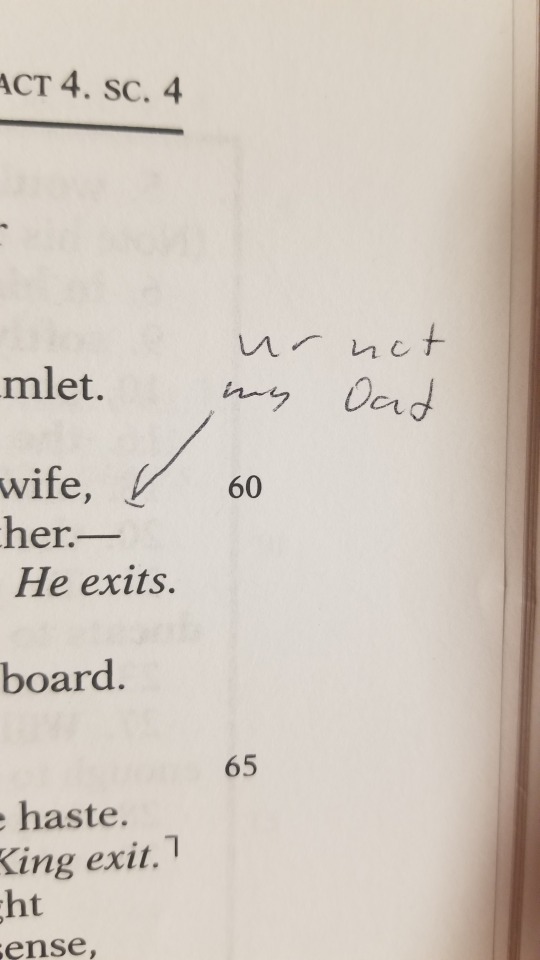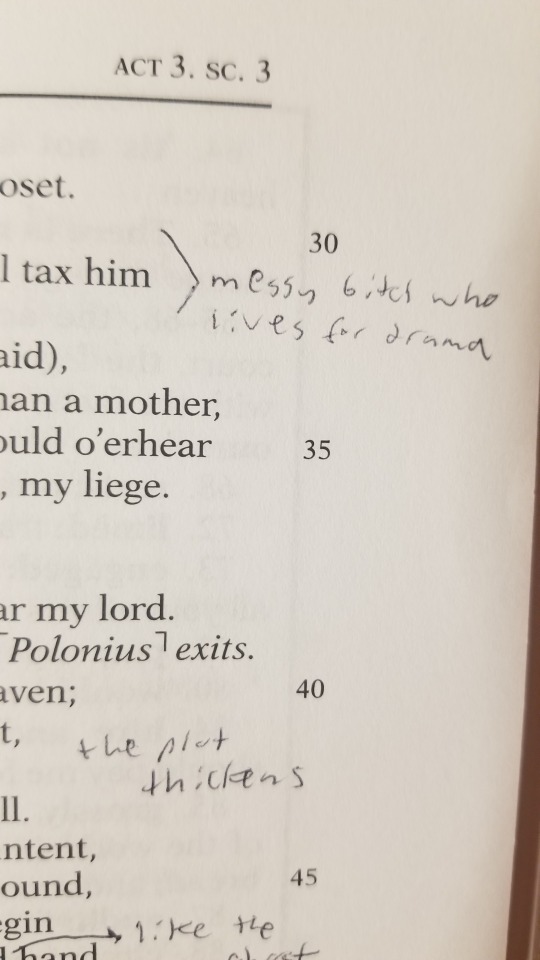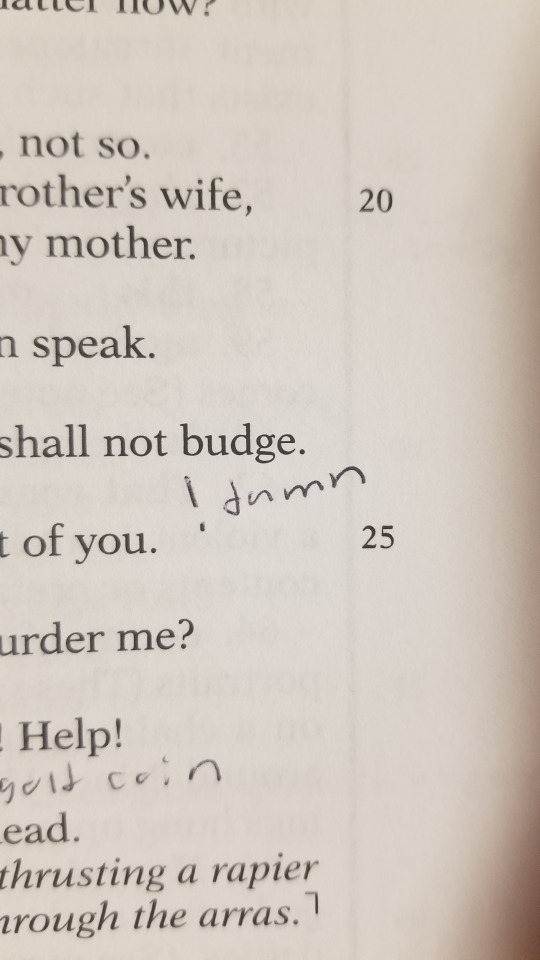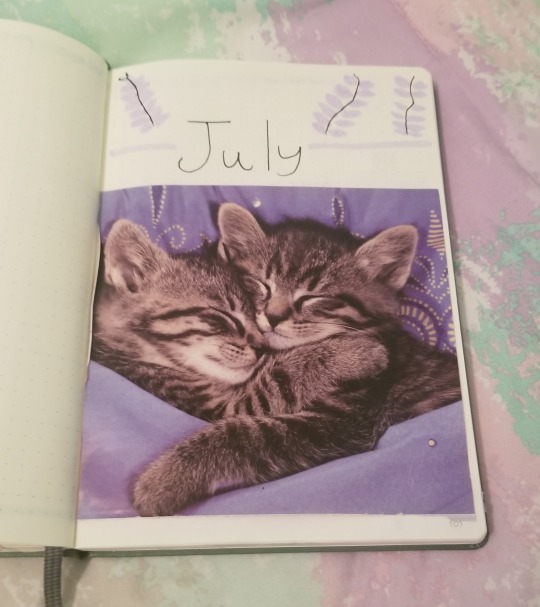#prometheankat
Text




some of my slightly unhinged Hamlet annotations #5
#prometheankat#hamlet notes#hamlet#shakespeare#english#english literature#literature#classic literature#books#annotating books#annotations#studyblr
25 notes
·
View notes
Text

current favorite study spot
#prometheankat#studyblr#coffee shop#cafe#aesthetic#Im just trying to live my m train life#Sitting in as many cafes as possible#studying#cafe aesthetic#coffeshop
10 notes
·
View notes
Text




some of my slightly unhinged Hamlet annotations #4
#prometheankat#hamlet notes#hamlet#shakespeare#english#english literature#studyblr#books#annotations#annotating books#literature#classic literature
16 notes
·
View notes
Text
july bujo




did a relaxing lavender-esque theme this month in hope that it will actually get me to relax for once in my life
11 notes
·
View notes
Text
I Read Every Hannibal Lecter Book (Review)
If you’re reading this, you’ve probably heard of the character Hannibal Lecter. Since his introduction in 1981, he’s gained a sense of infamy over the years, resulting in multiple movie and tv adaptations. Whether you first became aware of him through one of these or through the book series he originated from, it’s clear that something about him has captivated audiences for over forty years. So I went all the way back to the beginning to find out why. In this review, I’ll be covering all four of the original Hannibal Lecter books written by Thomas Harris. While not all of the books take place in chronological order, I will be reviewing them in the order they were published. As a precaution, there will be spoilers for every book mentioned and I will also be talking about sensitive subjects, including but not limited to: cannibalism and murder. Please read at your own discretion.
If you prefer to listen to your book reviews, this material is also in a youtube video you can access here: https://youtu.be/LKXrKhkO1vU
To start talking about Hannibal Lecter, we have to go back to his very first appearance. Red Dragon was first published in 1981 and focuses on former FBI profiler Will Graham as he hunts down a serial killer known as “The Tooth Fairy.” While this novel is most notable for introducing Hannibal Lecter, who only appears during a small portion of the book, it is also a remarkable read all on its own. The name was inspired by artist William Blake’s watercolor paintings, The Great Red Dragon and the Woman Clothed in Sun which depict various scenes from the Book of Revelation. These paintings are also an important part of the book’s plot, starting a series trend of the importance of outside inspiration and research to the books. Harris does a startling amount of research, from the more expected classes and interviews with the FBI to various pieces of art, literature, history, and science that he draws on for inspiration. It’s common for the acknowledgements of a Hannibal Lecter book to reference other media and the various people he consulted while working on the project. This was easily one of my favorite parts of the books, because I got to learn about a new and interesting topic along with Harris, from Italian Literature to post-occupation France to African moths. You never know what you’re going to get. One of the things I found most interesting in Red Dragon was the incredible detail on the different aspects of FBI investigations in the 1980s, which was fascinating to read today. But outside of the research he does, where Harris really shines is in creating remarkable characters. While the easiest and most prominent example of this is Hannibal Lecter, whose infamy speaks for itself, the far more interesting characters in Red Dragon are Will Graham and Francis Dolarhyde. Throughout the book, Harris switches perspectives between different characters, allowing us to spend time inside the minds of serial killers and FBI profilers alike. It was fascinating to me to read how Graham thinks about crime scenes or how Dolarhyde’s backstory turned him into a killer. Harris has a knack for creating complex and interesting characters. This extends to the relationships between these characters, such as when Dolarhyde falls for his coworker, Reba McClane. The exploration of their relationship and how it changes the characters is handled incredibly well throughout the book.
This great characterization continues in the second and arguably most famous book in the Hannibal Lecter series, The Silence of the Lambs. Published in 1988, the book follows FBI trainee Clarice Starling as she seeks the help of Hannibal Lecter on catching “Buffalo Bill,” the FBI’s nickname for a serial killer known for skinning his victims. Starling uses Lecter’s advice and her own intuition to catch Buffalo Bill on her own, whose real name ends up being Jame Gumb, before he can kill his latest victim, the Tennessee senator’s daughter. The novel ends with Starling gaining acclaim at the FBI and Lecter escaping from custody, telling Starling in a letter that he has no plans to call on her because “the world is more interesting with her in it.” This book is really Harris at his best, the pacing is perfectly balanced and the story keeps you hooked from the beginning to the end. I struggled to find a good focus for this paragraph because there isn’t much to say about this book besides the fact that it’s just so good. I could talk about the masterful use of suspense or the oscar-winning film adaptation, but most everything about this book has already been said. If there’s anything you should take from this needlessly lengthy review, it’s to read The Silence of the Lambs. It’s just something you have to experience for yourself. But despite all the amazing things one could say about this book, my favorite will always be the character of Clarice Starling. Where do I begin with Clarice? This book and Hannibal (the other book, not the NBC series), despite what their names and summaries and pop-culture references might suggest, are not about Hannibal Lecter. He’s just an important character in Clarice’s story and her development. Their relationship forces her to look within and discover new parts of herself which help her rise to the occasion. Clarice is the heart and center of the story. Without her, the book wouldn’t be complete. My all-time favorite scene in the book is after the senator takes Clarice off the case, she refuses to give up and goes to where Lecter has been relocated to try to get one more piece of information out of him. The scene perfectly encapsulates Clarice’s drive and strong moral compass. Her empathy is evident as she pushes forward not for the senator or the FBI or for Lecter, but for the victim she saw at the autopsy, and all the victims that came before her. For me, this scene cemented Clarice as a character I just couldn’t stop reading about.
Her story, along with Lecter’s, continues in the third book of the series, eloquently titled just Hannibal. While The Silence of the Lambs remains an objectively better book, and probably the best in the series, this one is far more interesting to look at and analyze. Released in 1999, the novel takes place after The Silence of the Lambs and follows the same characters, namely Hannibal and Clarice. The best way to describe the plot is that of three narratives stacked on top of each other wearing a trench coat. The first plotline introduced in the book follows Clarice and her struggles with the FBI as a drug raid gone wrong brings her under intense scrutiny from the public and from her superiors. We also learn that her once promising career has been sabotaged by her corrupt coworker, Paul Krendler, after she refused to sleep with him. We start the second plotline when Hannibal sends her a letter expressing his condolences and offering her advice, learning along the way that he has fled to Italy and is living under an assumed name. Alienated from the rest of the FBI, Jack Crawford puts Clarice in charge of apprehending Hannibal. Meanwhile, in the third and final plotline, we meet our main villain for this book, Mason Verger, a bed-ridden, wealthy sadistic pedophile. With the help of Sardinian assassins, he plots revenge on Hannibal for disfiguring him years earlier while acting as his therapist. The plan? To feed Hannibal to a new breed of pigs he created that will eat him alive, all while using Clarice as bait. Because of his immense wealth and power, Mason is able to offer a bounty on Hannibal, which is picked up by Italian Inspector Rinaldo Pazzi. When the kidnapping proves unsuccessful, with Hannibal disemboweling Pazzi, he flees to the United States and attempts to deliver a birthday gift to Clarice. While he is captured by Mason, Clarice pursues him but is shot by a tranquilizer dart and Hannibal carries her to safety. Mason is killed by his sister, Margot, and after acquiring his sperm so she can claim their whole inheritance, she pins the murder on Hannibal. The book doesn’t end there, but considering just how controversial the ending is, I’ll save it for the end of my analysis.
Opinions on this book are far more mixed than those which came before it. To get it out of the way, my main issue with this book is the pacing. While my summary of the events in Italy took barely two sentences, in the book it takes over two hundred pages. There’s far too much focus on the two characters carrying this plotline: Hannibal Lecter and Rinaldo Pazzi. Firstly, Hannibal doesn’t work well as a main character. The horror and intrigue that surrounded him and cemented his place in pop culture comes from his sparse appearances in the first book, all while primarily in captivity. Allowing him to roam the world freely and with more focus on him removes the interest. Although this is in some part necessary for the ending to work at all, this could be achieved to much better success by continuing to focus on Clarice. For large parts of the story, we drift away from her narrative, therefore losing the heart of the story. By continuing to use Hannibal as a supporting character in her story, it allows them both to develop without losing much of what makes Hannibal, well, Hannibal. Secondly, the Italy part drags on for far too long. Pazzi, while sometimes interesting, is not nearly enough to carry this plotline to completion. He really only works as a foil to Clarice, which does not warrant two hundred pages of this storyline. Throughout the book, both him and Clarice experience a disillusionment with their respective federal establishments, but react in very different ways. While Clarice sticks to her own sense of personal honor and moral code, continuing her character traits established in The Silence of the Lambs, Pazzi turns to greed and avarice, continuing the connection to his ancestor mentioned in the book. This also starts the themes of greed and taste that continue over the course of the book. When Clarice sets out to catch Hannibal, she uses his tastes in food, music, cars, and other luxuries to track him down. But Mason, while also significantly wealthy, has far more greed than taste. Not only is his role as a villain crucial for cementing these themes, he also serves as a way to further tie Hannibal and Clarice together. From his very introduction, he is described as something less than human, his demeanor consistently compared to deep sea creatures and the eel he keeps in his room. He is a monster who preys on children and continuously abuses his sister. Not only does this lessen Hannibal’s past crimes significantly, it also creates a comparison between his motives to Mason’s, who is motivated by both revenge and a sick pervertedness. His mission to capture and torture Hannibal turns a serial killer into someone the audience roots for against their better judgement. It also puts him and Clarice on the same team, both of them united against Mason physically and morally.
All of this builds up to the eventual ending, where after psychoactive drugs and communal brain-eating, Hannibal and Clarice become lovers and disappear together. You can understand why it was so controversial. I actually loved the ending. In my mind, the pieces for their relationship were planted way back in their first meeting. In The Silence of the Lambs, Hannibal manipulates a man to kill himself after he insults Clarice, where he dies by quite literally eating his words, by which I mean his tongue. He also notices and is concerned when Clarice is injured, not to mention his line, “people will say we’re lovers.” Hannibal also does a good job building to their eventual relationship. Clarice loses the stability of the FBI in her life after being put on probation. Her only confidant there, Jack Crawford, grows closer and closer to retirement with each passing day. Her closest friend, Ardelia, has other friends and connections she can rely on, a life she can turn to if Clarice leaves. Losing her reliance and affection for institutions allows Clarice to grow, letting go of her childhood traumas, which allows her to embrace Hannibal as a lover. The previously mentioned brain-eating was also of one Paul Krendler, the aforementioned awful FBI employee who tormented Clarice, which makes the scene overall more cathartic than terrifying. My only issue with the ending is that it’s far too short. I could have used less time spent in Italy and far more time to focus on Clarice and Hannibal’s feelings changing and evolving after their escape from Mason Verger. While this book might just be my favorite in the Lecter series, I still think it could have used more Clarice Starling. Which is unfortunate, since the fourth and final book contains no Clarice at all.
And so we end where we begin, as the last book chronicles the rise of the titular character, Hannibal Lecter. Hannibal Rising, released in 2006, is a prequel that explores the childhood and teen years of Hannibal, spanning from Lithuania during World War II to post-occupation France. As a child, Hannibal’s family was killed by a German dive bomber save for him and his sister, Mischa. When their family’s lodge was occupied by deserters, their lack of supplies led them to cannibalize Mischa. Hannibal has now lost all of his family, save for his uncle, who takes Hannibal to stay with him and his wife, Lady Murasaki, in France. Hannibal becomes a successful medical student and also carries out his first kill, a butcher who insulted his aunt. After remembering details about his sister's killers, he returns to Lithuania and begins a quest of revenge. In the process, he barely escapes the scrutiny of the french police, successfully avenges his sister, and loses the favor of Lady Murasaki. At the end of the book, he moves to the United States, beginning to resemble the character’s first appearance all the way back in Red Dragon. The origin of this book is complicated, to say the least. De Laurenttis, a producer on multiple Hannibal film adaptations, admits in an EW interview to telling Harris, “if you don’t do [the prequel], I will do it with someone else. . . I don’t want to lose this franchise. And the audience wants it.” If this assertion is true, it certainly puts Harris in a tricky spot. Write a prequel you never wanted to write in the first place or lose one of the most important characters you’ve ever created? You and I already know the answer. While the book itself isn’t spectacular, I much prefer the story coming from the mind of the original author rather than someone like De Laurenttis turning it into another overdone horror franchise. With Harris, it still feels like a Hannibal Lecter novel. The beginning was very boring, which is partially fueled by my lack of interest in the German occupation of Lithuania, but it got better the further along I got. You just have to stick with it. While the story is not nearly as remarkable as its predecessors, there is still some interest in Hannibal’s revenge schemes or his incredibly complicated relationship with his aunt. One of my favorite parts was the continued use of birds as a metaphor, contrasting the frozen birds Hannibal sees his captors eating at the beginning of the novel to him releasing exotic birds many years later, showing a complete arc of his character that turns him into what we know as Hannibal Lecter. It also ties back to a comment he made about Clarice in Hannibal, in which he compares her to a type of bird that completes intense dives, further cementing their two characters together. Overall, the book does a good job at orienting itself amidst the rest of the series, not standing too at odds with what we already know and love.
I certainly loved reading these books. I wish I had some sort of snappy takeaway from this, something to show for the two thousand words I wrote about books that largely came out before I was born. I could say I learned how to write better characters, better suspense, better books. I learned how to create a mind palace and hypothetically train pigs to eat men alive. I read hundreds of pages about beheadings, disembowelings, and skinnings. I found a connection to these characters. But the impact these books have had on me and on thousands of others is more than words. There’s something ephemeral about them that has captured me in their web, something that has turned a side character into an international phenomenon. If you, like me, want to know what makes Hannibal Lecter so infamous, you just have to experience it for yourself. Read the books, I promise you won’t regret it.
#prometheankat#book review#books#bookblr#reading#essays#reviews#hannibal#hannibal lecter#red dragon#the silence of the lambs#hannibal rising#thomas harris
13 notes
·
View notes
Text
youtube
new vid :)
#prometheankat#hawaii#maui#travelling#travel#vlog#travel vlog#beach#beach aesthetic#vacation#Youtube
3 notes
·
View notes
Text
youtube
new vid. watch if you want
#prometheankat#the girls#book review#books#emma cline#fiction#bookblr#youtube#video#my video#video essay#video review#manson family#Youtube
3 notes
·
View notes
Text
youtube
my first ever youtube video is up!
2 notes
·
View notes
Text

didion in the park
#prometheankat#aesthetic#I guess??#At least my nails look cute#joan didion#Let me tell you what i mean#Reading#Books#bookblr
1 note
·
View note
Text
The Girls is Not That Good - review
video version here: https://youtu.be/0xCFmudBbos
I recently found out via email newsletter that Emma Cline has a new book out. I’ve been told that reviews for her second book, The Guest, have been overwhelmingly positive, although I must admit that I have not read any of these reviews or the actual book itself. I have, however, read her debut novel, The Girls, and this new release reminded me that I never actually published a review for it and now I’m going to make it everyone’s problem. So, in this essay I’ll be covering the book and my thoughts on it, most of which aren’t that positive. There will be spoilers and I’ll be covering sensitive subjects related to cults and murder, so view at your own discretion.
To start us off, The Girls was originally published in 2016 by Random House and is Emma Cline’s first published novel. Loosely inspired by the infamous Manson family murders, its plot follows 14-year-old Evie Boyd as she is caught up in a group of spellbinding girls and the man/cult leader they all follow, Russell. The book was the winner of the Shirley Jackson Award for Best Novel 2016 and was a Goodreads Choice Award Nominee for Best Fiction 2016. Sounds like a pretty good book, right? Many other readers and reviewers would agree with you, like the Washington Post and NPR. I, however, would not, as you have probably already guessed from the title of this review. I have a few different problems with this novel, the first of which is the fact that the author managed to make something as fascinatingly macabre and intriguing as boring as my high school finance class.
The real life story behind Charles Manson and the so-called Tate Murders is almost horrifically interesting. I read Helter Skelter by Vincent Bugliosi, a true crime novel about the case written by the actual prosecutor for the trial, right before I read The Girls, which is part of the reason The Girls felt so flat to me. Helter Skelter is a gripping, horrifying beast of a book. It sucks you in and refuses to let you go until you’ve learned every gritty, gory detail. Bugliosi’s intimate knowledge of the case makes him the perfect storyteller, as he leads you through every small clue and motive that build the case against Charles Manson and his oh-so-devoted followers. There’s so much to the story that has already been said both by Bugliosi and other creators in the past fifty years that a retelling like The Girls has to find something new and exciting to shed line on, a whole new avenue to explore. This book just doesn’t do that. Cline doesn’t really have anything new to say.
Our main character, Evie, is a perpetual outsider. In this way, she acts like an audience-insert, allowing us a peek into the dark world that she’s stumbled upon. And there’s nothing wrong with this premise besides the fact that Evie doesn’t really do anything. Whether it’s because the author didn’t want to offend any of the real life people involved in the Manson family by basing a character on them or because she didn’t want to implicate her character in their crimes, therefore absolving her of guilt, this decision forces Evie to lurk outside of her own narrative. She isn’t allowed to do anything new, so the book never delves into uncharted territory. The story would have happened the exact same even if Evie had never existed at all, which is not a good thing for people to say about your main character. And because of this, the book really lacks a solid purpose. It fails to explore anything at all.
The same is true for the plot, which is largely a gross simplification of real life events with a few spatterings of original writing that serve as our look into the future. Obviously, no retelling that is “inspired by” true events will line up perfectly with reality, but rather than taking an interesting concept and adding something new or turning it on its head, this book makes it boring and pedestrian. In the real world, Manson’s motives are a complex and confusing amalgamation of race wars, prejudice, post apocalyptic futures, dune buggies, Beatles lyrics, and miscellaneous Biblical influences. They’re a mess and they barely make sense, but that’s what makes it interesting. The search for a motive in the mountains of evidence is one of the most important parts of the prosecution case explained in Helter Skelter. In contrast, our Manson stand-in featured in The Girls wants to kill people because Mitch, our resident Beach Boy stand-in, couldn’t get him a record deal. Which is mind numbingly boring, especially when the other option is a madman’s belief that he is Jesus and killing any random influential person will start a war where him and his family will be the only survivors, all because they hunkered down in the desert on dune buggies. Like, it’s pure insanity, but it’s interesting to read about. The motives are the most glaring example I can provide, but The Girls simplifies pretty much every true event it draws inspiration from. And in that aspect, the plot really falls flat.
The other parts of this book are comprised of Cline’s original ideas, particularly inventions about Evie’s family, friends, and future. Some of these portions take place in the future, following Evie as an aimless middle-aged woman currently house-sitting for a friend. When said friend’s teenage son and his girlfriend show up, we get some good interactions between Evie and the girlfriend, Sasha. I actually really enjoyed these sections, especially seeing how Evie saw herself in Sasha and tried to help her despite Sasha’s own wishes. All of the original writing wasn’t bad. The only time it fell flat was when it ventured back to the main plot, which was most of the book.
And that’s what’s really the most disappointing thing about this book. There’s just so much wasted potential. This could have been interesting. This could have been amazing. I could have really enjoyed this. I actually really enjoy the idea behind it, which is why I picked up this book in the first place. Showing a girl’s perspective of these events, showing how someone vulnerable could get drawn into a cult would be an interesting area to explore. Especially when combined with how women were treated during the time period contrasted with how they were the actual ones doing the murdering, there’s a lot of interesting concepts in the idea alone. This could have been a much deeper, twisted exploration of some really cool ideas, if only the author wasn’t scared to commit to the actual cult material. Most of the story is built around it, but we never really explore it. It’s just another thing that happens because the plot demands so. Why write a book about a cult if you aren’t going to really go for it? Why do it at all? This book could have been so much better if Cline did commit to it. Or, alternatively, I think she could have written a really great novel if she just used her own original ideas. Her writing in the future sections was really good and I’m sure that a story where she isn’t bound to a historical inspiration could be really good. Either of those options would have been better than the book she actually wrote.
Maybe I will read The Guest. Maybe it will be better than The Girls. But when it comes to The Girls, if you’re looking for a story about cults and murder in the sixties, just read Helter Skelter. Or if you don’t want to do that, you can just skim the Wikipedia page for Charles Manson. Either option would be more interesting. Because oftentimes, reality is much, much stranger than fiction.
#the girls#emma cline#the guest#book review#prometheankat#book critique#book criticism#bookblr#reviews#charles manson#i guess?#fiction
1 note
·
View note
Text

Editing at the library again
#prometheankat#libraries#Library#day in the life#Editing#Youtube#Got the best spot in the library again#Hallelujah
0 notes
Text


rainy days + twilight
0 notes
Text
youtube
promoting this again, check it out if you like (somewhat short) video essays
1 note
·
View note
Text


Early mornings/late afternoons at the library
1 note
·
View note